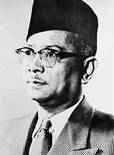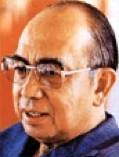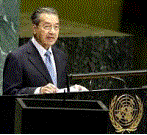by Ronald D. Palmer
At a ceremony at the Malaysian Embassy in Washington marking the fiftieth anniversary of Malaysian independence on November 17, 2007, Ambassador Ron Palmer, who was ambassador to Malaysia in 1981-82 and served as president of the Malaysia America Society from 1994 to 2000, gave a talk reflecting on his 60 years of studying and serving in that fascinating country. Following are his remarks. — Ed.
I have been studying Malaya and Malaysia for 60 years, not just the 50 years since its independence. I widened my focus in 1947, at the age of 15, from mainly studying wartime and postwar Europe, when I decided to follow Ralph Bunche into a diplomatic career.
At that time the major news magazines — Time, Newsweek, U.S. News & World Report — had excellent reporters on Asian events, and I began following the area, especially Indochina and Malaya. The arrogant colonial French never understood the motivations of the Vietnamese. The equally arrogant British, it seemed to me, had a better grasp of the motivations of the peoples of Borneo and the Malay Peninsula, and how British interests could be protected and promoted in the post-1945 world.
I came to share the admiration of the British for Malay leader Tunku Abdul Rahman, who seemed to be as deft at playing the British as they were at cultivating him. He had a charming mantra to explain the slow pace of his studies of law in Britain: He said he was hampered in his academic efforts by fast women and slow horses.
I maintained my interest in Malaya at Howard from 1950 to 1954.
I was a Fulbright student in France in 1954-55 when the British and Malayan elites were in the last stages of managing the transition to independence. I was in Bordeaux but followed events in Malaya in the British Sunday papers.

Prime Minister 1957-70
Meanwhile, having been defeated in Indochina, the French fecklessly waged war to attempt to retain Algeria.
After 1955-57 study at SAIS (Johns Hopkins School of Advanced International Studies), I joined the Foreign Service in 1957 and was assigned to frantic Jakarta in 1960. It was a relief to be assigned to calm Kuala Lumpur in 1962. I even got to know Tunku Abdul Rahman a little at my lowly Third Secretary position in the embassy economic section, because we shared a love of racing, and I gladly accepted his invitations to diplomatic corps members to share his box at the Kuala Lumpur racetrack. He would even hand sandwiches around to guests at tea time.
I had met Sukarno only once, and he didn’t seem particularly to enjoy the experience.
Tunku was very kind to me when I returned to Kuala Lumpur as ambassador in 1981.
As a junior member of the embassy in 1962-63, I had many opportunities to escort official visitors to witness Deputy Prime Minister Tun Razak’s stern and searching examinations of Malaysian officials on development issues. I also had many rich encounters with Minister of Finance and Malaysian Chinese Association leader Tan Siew Sin, who later enabled me to visit his ancestral home in Malacca.
Foreign Ministry Permanent Secretary Ghazali was far above me in status and responsibility at that time, and I had rare encounters with him. However, I watched with bemusement after 1963 as he maneuvered Malaysia and Indonesia to an end of confrontasi and the establishment of the conditions for launching ASEAN (the Association of Southeast Asian Nations) in 1967. Ghazali was Foreign Secretary when I returned as ambassador in 1981. He delighted in pestering me when he periodically summoned me to his office. I tried to give as well as I got.
I traveled widely in 1962-63. I became aware of the depth of the ethnic divisions in the country, and I guessed that trouble lay ahead for the Malaysian leadership, so the 1969 riots were not a surprise. I was impressed, however, at how quickly the situation was brought under control. I felt that the difficulties could be overcome.
I had watched Malaya as it morphed into Malaysia in 1963 from my postings in Washington, Copenhagen, and West Point until 1969, when I was assigned to be the number two on the Philippine desk in the State Department. I frequently attended East Asia Bureau staff meetings, representing my boss, Richard Usher. Those meetings could be quite electric, as Malaysia-Singapore desk officer Maurice Bean parried the skeptics of the bureau leadership about the strategy and tactics of the post-Tunku, post-1969-riots Razak government.
Bean was insistent that Razak knew what he was doing and that Malaysia would not descend into civil chaos. Assistant Secretary Marshall Green was coolly skeptical but went along with Bean’s advice to let the Malaysian leadership sort things out their own way.

By the time I was assigned to Manila in 1971, the Razak government had set the stage for a return to parliamentary rule, led by UMNO (the United Malay Nationalist Organization).
ASEAN had been born in 1967, and Razak was content to let it emerge from its infancy with “all deliberate speed.” This suited the United States as well.
Magisterial U.S. Ambassador Jack Lydman was in Kuala Lumpur from 1969 to 1974 and had helped shape a pragmatic U.S. policy. He had been my economic section boss in Jakarta. He was followed from 1974 to 1976 by the equally cool, pragmatic, and brilliant Ambassador Frank Underhill, who had been political section chief in my 1962-63 KL interlude. The standard of ambassadorial excellence continued from 1976 to 1980 with the appointment of Bob Miller. He laid the basis for the great improvement in bilateral relations his successors Barbara Watson and I were able to enjoy.
I arrived in Kuala Lumpur in 1981 and left in 1983. This was the period of ascendancy of Prime Minister Mahathir Mohamad. He and I were on good personal and policy terms when I left. He even told me I had done a good job.
By the mid-1980s a sturdy foundation of bilateral cooperation had been built on political and national security interactions. Economic cooperation also greatly intensified after Malaysia’s economic recession of 1986, and U.S.-Malaysia trade boomed.

The authority, dash, and reach of Prime Minister Mahathir boomed, nay blossomed, in the late 1980s and the 1990s. American ambassadors and the State Department had interesting and sometimes difficult times in this era of Mahathir’s growing national dominance and the assertion of Malaysian international and Third World leadership. However, the U.S.-Malaysian bond was sound, and Prime Minister Abdullah Badawi inherited a thriving relationship when he came to power in 2003.
Many people deserve credit for nurturing this relationship. The Malaysia America Society played a useful role.![]()

Ron Palmer, in addition to his two tours of duty in Malaysia described in the article, served as U. S. ambassador to Togo and Mauritius as well as Deputy Director General of the Foreign Service during his 32-year diplomatic career. A member of the American Diplomacy Publishers board of directors and a frequent contributor to the journal, he is now professor emeritus at The George Washington University in Washington, D. C.
